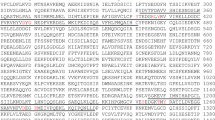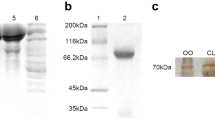Abstract
The primordial germ cells (PGCs) in the oligochaete annelid Tubifex tubifex are mesodermal in origin and are located in the two midbody segments X and XI in which the testis and the ovary are formed, respectively. To identify a molecular marker for the Tubifex PGCs, we isolated the Tubifex homologue (Ttu-vas) of the Drosophila vasa gene. Using whole-mount in situ hybridization, we examined the spatial expression patterns of Ttu-vas from one-cell stage through juvenile stage. Ttu-vas messenger ribonucleic acid (RNA) is present as a maternal transcript distributed broadly throughout the early stages. Ttu-vas is expressed in all of the early cleavage blastomeres, in which Ttu-vas RNA associates with mitotic spindles and pole plasms. Expression of Ttu-vas gradually becomes restricted, first to teloblasts, then to their blast cell progeny comprising the germ bands (GBs), and finally to a set of large ventral cells (termed VE cells) in a variable set of midbody segments including the genital segments (X and XI). At the end of embryogenesis, VE cells are confined to genital segments where they are presumably germline precursors in the juvenile. Staining with a cross-reacting anti-Vasa antibody suggested that VE cells express Ttu-vas protein to the same extent irrespective of their positions along the anteroposterior axis. A set of cell ablation experiments suggested that VE cells are derived from the mesodermal teloblast lineage and that the emergence of VE cells takes place independently of the presence of the ectodermal GBs that normally overlay the mesoderm. These results suggest that T. tubifex generates supernumerary presumptive PGCs during embryogenesis whose number is variable among embryos.










Similar content being viewed by others
References
Braat A, Zandbergen T, van de Water S, Goos H, Zivkovic D (1999) Characterization of zebrafish primordial germ cells: morphology and early distribution of vasa RNA. Dev Dyn 216:153–167
Brusca RC, Brusca GJ (2003) Invertebrates, 2nd edn. Sinauer, Sunderland
Chang CC, Dearden P, Akam M (2002) Germ line development in the grasshopper Schistocerca gregaria: vasa as a marker. Dev Biol 252:100–118
Dearden P, Grbic M, Donly C (2003) Vasa expression and germ-cell specification in the spider mite Tetranychus urticae. Dev Genes Evol 212:599–603
Dixon GC (1915) Tubifex. In: Herdman WA (ed) L. M. B. C. Memoirs on typical British marine plants and animals, vol. 23. Williams and Norgate, London, pp 1–100
Fabioux C, Huvet A, Lelong C, Robert R, Pouvreau S, Daniel JY, Minguant C, Le Pennec M (2004) Oyster vasa-like gene as a marker of the germline cell development in Crassostrea gigas. Biochem Biophys Res Commun 320:592–598
Extavour CG (2005) The fate of isolated blastomeres with respect to germ cell formation in the amphipod crustacean Parhyale hawaiensis. Dev Biol 277:387–402
Extavour CG, Akam ME (2003) Mechanisms of germ cell specification across the metazoans: epigenesis and preformation. Development 130:5869–5884
Extavour CG, Pang K, Matus DQ, Martindale MQ (2005) vasa and nanos expression pattern in a sea anemone and the evolution of bilaterian germ cell specification mechanisms. Evol Dev 7:201–215
Fujimura M, Takamura K (2000) Characterization of an ascidian DEAD-box gene, Ci-DEAD1: specific expression in the germ cells and its mRNA localization in the posterior-most blastomeres in early embryos. Dev Genes Evol 210:64–72
Fujimoto T, Kataoka T, Sakao S, Saito T, Yamaha E, Arai K (2006) Developmental stages and germ cell lineage of the loach (Misgurnus anguillicaudatus). Zool Sci 23:977–989
Goto A, Kitamura K, Arai A, Shimizu T (1999a) Cell fate analysis of teloblasts in the Tubifex embryo by intracellular injection of HRP. Dev Growth Differ 41:703–713
Goto A, Kitamura K, Shimizu T (1999b) Cell lineage analysis of pattern formation in the Tubifex embryo. I. Segmentation in the mesoderm. Int J Dev Biol 43:317–327
Jamieson BGM (2006) Non-leech Clitellata. In: Rouse G, Pleijel F (eds) Reproductive biology and phylogeny of annelida. Science Publishers, Enfield, pp 235–392
Kang D, Pilon M, Weisblat DA (2002) Maternal and zygotic expression of a nanos-class gene in the leech Helobdella robusta: primordial germ cells arise from segmental mesoderm. Dev Biol 245:28–41
Kitamura K, Shimizu T (2000a) Embryonic expression of alkaline phosphatase activity in the oligochaete annelid Tubifex. Invert Reprod Dev 37:69–73
Kitamura K, Shimizu T (2000b) Analyses of segment-specific expression of alkaline phosphatase activity in the mesoderm of the oligochaete annelid Tubifex: implications for specification of segmental identity. Dev Biol 219:214–223
Knaut H, Pelegri F, Bohmann K, Schwarz H, Nüsslein-Volhard C (2000) Zebrafish vasa RNA but not its protein is a component of the germ plasm and segregates asymmetrically before germline specification. J Cell Biol 149:875–888
Krovel AV, Olsen LC (2002) Expression of a vas::EGFP transgene in primordial germ cells of the zebrafish. Mech Dev 116:141–150
Lambert JD, Nagy LM (2002) Asymmetric inheritance of centrosomally localized mRNAs during embryonic cleavages. Nature 420:682–686
Lasko P, Ashburner M (1988) The product of the Drosophila gene vasa is very similar to eukaryotic initiation factor-4A. Nature 335:611–617
Mann KH (1962) Leeches (Hirudinea). Pergamon, Oxford
Matsuo K, Shimizu T (2006) Embryonic expression of a decapentaplegic gene in the oligochaete annelid Tubifex tubifex. Gene Expr Patterns 6:800–806
Matsuo K, Yoshida H, Shimizu T (2005) Differential expression of caudal and dorsal genes in the teloblast lineages of the oligochaete annelid Tubifex tubifex. Dev Genes Evol 215:238–247
Meyer A (1929) Die Entwicklung der Nephridien und Gonoblasten bei Tubifex rivulorum Lam. nebst Bemerkungen zum naturlichen System der Oligochäten. Z Wiss Zool 133:517–562
Meyer A (1931) Cytologische Studien über die Gonoblasten und andere ähnliche Zellen in der Entwicking von Tubifex. Z Morph Oekol Tiere 22:269–286
Nakamoto A, Arai A, Shimizu T (2000) Cell lineage analysis of pattern formation in the Tubifex embryo. II. Segmentation in the ectoderm. Int J Dev Biol 44:797–805
Nakamoto A, Arai A, Shimizu T (2004) Specification of polarity of teloblastogenesis in the oligochaete annelid Tubifex: cellular basis for bilateral symmetry in the ectoderm. Dev Biol 272:248–261
Nakao H (1999) Isolation and characterization of a Bombyx vasa-like gene. Dev Genes Evol 209:312–316
Otani S, Maegawa S, Inoue K, Arai K, Yamaha E (2002) The germ cell lineage identified by vas-mRNA during the embryogenesis in goldfish. Zool Sci 19:519–526
Pelegri F, Knaut H, Maischein H-M, Schulte-Merker S, Nüsslein-Volhard C (1999) A mutation in the zebrafish maternal-effect gene nebel affects furrow formation and vasa RNA localization. Cur Biol 9:1431–1440
Penners A, Stäblein A (1930) Über die Urkeimzellen bei Tubificiden (Tubifex rivulorum Lam. und Limnodrilus udekemianus Claparede). Z Wiss Zool 137:606–626
Pokrywka NJ (1995) RNA localization and the cytoskeleton in Drosophila oocytes. In: Capco DG (ed) Cytoskeletal mechanisms during animal development. Academic, San Diego, pp 139–166
Rebscher N, Zelada-Gonzalez F, Banisch TU, Raible F, Arendt D (2007) Vasa unveils a common origin of germ cells and of somatic stem cells from the posterior growth zone in the polychaete Platynereis dumerilii DOI 10.1016/j.ydbio.2007.03.521
Sagawa K, Yamagata H, Shiga Y (2005) Exploring embryonic germ line development in the water flea, Daphnia magna, by zinc-finger-containing VASA as a marker. Gene Expr Patterns 5:669–678
Schröder R (2006) vasa mRNA accumulates at the posterior pole during blastoderm formation in the flour beetle Tribolium castaneum. Dev Genes Evol 216:277–283
Shinomiya A, Tanaka M, Kobayashi T, Nagahama Y, Hamaguchi S (2000) The vasa-like gene, olvas, identifies the migration path of primordial germ cells during embryonic body formation stage in the medaka, Oryzias latipes. Dev Growth Differ 42:317–326
Shimizu T (1982) Development in the freshwater oligochaete Tubifex. In: Harrison FW, Cowden RR (eds) Developmental biology of freshwater invertebrates. Alan R Liss, New York, pp 283–316
Shimizu T (1993) Cleavage asynchrony in the Tubifex embryo: involvement of cytoplasmic and nucleus-associated factors. Dev Biol 157:191–204
Shimizu T (1995) Role of the cytoskeleton in the generation of spatial patterns in Tubifex eggs. In: Capco DG (ed) Cytoskeletal mechanisms during animal development. Academic, San Diego, pp 197–235
Shimizu T (1996) Behaviour of centrosomes in early Tubifex embryos: asymmetric segregation and mitotic cycle-dependent duplicaton. Roux’s Arch Dev Biol 205:290–299
Shimizu T, Savage RM (2002) Expression of hunchback protein in a subset of ectodermal teloblasts of the oligochaete annelid Tubifex. Dev Genes Evol 212:520–525
Shirae-Kuribayashi M, Nishikata T, Takamura K, Tanaka KJ, Nakamoto C, Nakamura A (2006) Dynamic redistribution of vasa homolog and exclusion of somatic cell determinants during germ cell specification Ciona intestinalis. Development 133:2683–2693
Yisraeli J, Sokol S, Melton D (1990) A two-step model for the localization of maternal mRNA in Xenopus oocytes: involvement of microtubules and microfilaments in the translocation and anchoring of Vg1 mRNA. Development 108:289–298
Yoon C, Kawakami K, Hopkins N (1997) Zebrafish vasa homologue RNA is localized to the cleavage planes of 2- and 4-cell-stage embryos and is expressed in the primordial germ cells. Development 124:3157–3165
Yoshida-Noro C, Myohara M, Kobari F, Tochinai S (2000) Nervous system dynamics during fragmentation and regeneration in Enchytraeus japonensis (Oligochaeta, Annelida). Dev Genes Evol 210:311–319
Wolke U, Weidinger G, Köprunner M, Raz E (2002) Multiple levels of posttranscriptional control lead to germ line-specific gene expression in the zebrafish. Cur Biol 12:289–294
Zhou Y, King ML (1996) RNA transport to the vegetal cortex of Xenopus oocytes. Dev Biol 179:173–183
Acknowledgments
We are grateful to Drs. C. G Extavour and M. Akam, University of Cambridge, for the Vasa antibody. We also thank members of the Shimizu laboratory for advice and help in collecting embryos. This study was supported in part by a Grant-in-Aid from the Ministry of Education, Science, Sports and Culture, Japan (13680799) to T.S.
Author information
Authors and Affiliations
Corresponding author
Additional information
Communicated by: D.A. Weisblat
Electronic supplementary material
Below is the image is a link to a high resolution version.
Fig. S1
Characterization of Ttu-vas, a vasa homologue from T. tubifex. a Alignment of Ttu-Vas with known Vasa-class proteins. The eight conserved motifs of the DEAD-box protein family are boxed in black. The EARKF and WD motifs are boxed in red. Numbers in parentheses indicate the percentage amino acid identity with the overall sequences of Ttu-Vas. b Molecular phylogenetic relationship of Ttu-Vas to other DEAD-box proteins. The phylogenetic tree was generated by the neighbor joining method using PAUP*4.0b10. Dme-Abs was used as an outgroup. Numbers are bootstrap values (as percentages of 1000 replications). Lengths of branches are drawn to the scale indicated (Bmo Bombyx mori, Cgi Crassostrea gigas, Csa Ciona savignyi, Dma Daphnia magna Dme Drosophila melanogaster Dre Danio rerio, Gga Gallus gallus, Hma Hydra magnipapillata, Mmu Mus musculus, Ola Oryzias latipes, Pdu Platynereis dumerilii, Ttu Tubifex tubifex) (GIF 118 445 KB)
Fig. S2
Frequency of total number of ventral Ttu-vas-expressing cells present on the left (a) and right (b) side of individual embryos. Abscissa: developmental stages (16a to 18) and juvenile stages (Juv-D1 to D3) (GIF 28 879 kb)
Rights and permissions
About this article
Cite this article
Oyama, A., Shimizu, T. Transient occurrence of vasa-expressing cells in nongenital segments during embryonic development in the oligochaete annelid Tubifex tubifex . Dev Genes Evol 217, 675–690 (2007). https://doi.org/10.1007/s00427-007-0180-1
Received:
Accepted:
Published:
Issue Date:
DOI: https://doi.org/10.1007/s00427-007-0180-1




